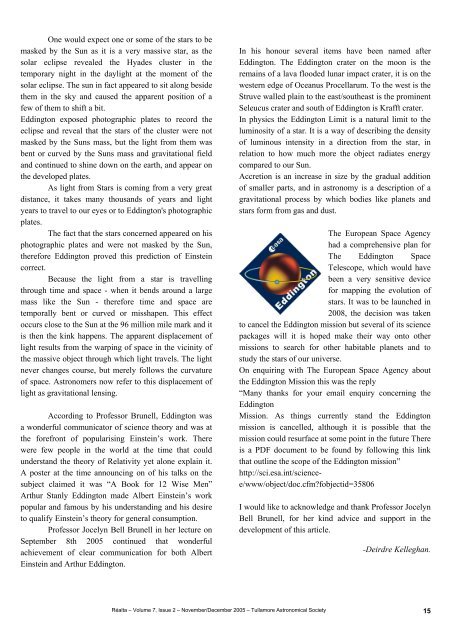Space - Tullamore Astronomical Society
Space - Tullamore Astronomical Society
Space - Tullamore Astronomical Society
Create successful ePaper yourself
Turn your PDF publications into a flip-book with our unique Google optimized e-Paper software.
One would expect one or some of the stars to be<br />
masked by the Sun as it is a very massive star, as the<br />
solar eclipse revealed the Hyades cluster in the<br />
temporary night in the daylight at the moment of the<br />
solar eclipse. The sun in fact appeared to sit along beside<br />
them in the sky and caused the apparent position of a<br />
few of them to shift a bit.<br />
Eddington exposed photographic plates to record the<br />
eclipse and reveal that the stars of the cluster were not<br />
masked by the Suns mass, but the light from them was<br />
bent or curved by the Suns mass and gravitational field<br />
and continued to shine down on the earth, and appear on<br />
the developed plates.<br />
As light from Stars is coming from a very great<br />
distance, it takes many thousands of years and light<br />
years to travel to our eyes or to Eddington's photographic<br />
plates.<br />
The fact that the stars concerned appeared on his<br />
photographic plates and were not masked by the Sun,<br />
therefore Eddington proved this prediction of Einstein<br />
correct.<br />
Because the light from a star is travelling<br />
through time and space - when it bends around a large<br />
mass like the Sun - therefore time and space are<br />
temporally bent or curved or misshapen. This effect<br />
occurs close to the Sun at the 96 million mile mark and it<br />
is then the kink happens. The apparent displacement of<br />
light results from the warping of space in the vicinity of<br />
the massive object through which light travels. The light<br />
never changes course, but merely follows the curvature<br />
of space. Astronomers now refer to this displacement of<br />
light as gravitational lensing.<br />
According to Professor Brunell, Eddington was<br />
a wonderful communicator of science theory and was at<br />
the forefront of popularising Einstein’s work. There<br />
were few people in the world at the time that could<br />
understand the theory of Relativity yet alone explain it.<br />
A poster at the time announcing on of his talks on the<br />
subject claimed it was “A Book for 12 Wise Men”<br />
Arthur Stanly Eddington made Albert Einstein’s work<br />
popular and famous by his understanding and his desire<br />
to qualify Einstein’s theory for general consumption.<br />
Professor Jocelyn Bell Brunell in her lecture on<br />
September 8th 2005 continued that wonderful<br />
achievement of clear communication for both Albert<br />
Einstein and Arthur Eddington.<br />
In his honour several items have been named after<br />
Eddington. The Eddington crater on the moon is the<br />
remains of a lava flooded lunar impact crater, it is on the<br />
western edge of Oceanus Procellarum. To the west is the<br />
Struve walled plain to the east/southeast is the prominent<br />
Seleucus crater and south of Eddington is Krafft crater.<br />
In physics the Eddington Limit is a natural limit to the<br />
luminosity of a star. It is a way of describing the density<br />
of luminous intensity in a direction from the star, in<br />
relation to how much more the object radiates energy<br />
compared to our Sun.<br />
Accretion is an increase in size by the gradual addition<br />
of smaller parts, and in astronomy is a description of a<br />
gravitational process by which bodies like planets and<br />
stars form from gas and dust.<br />
The European <strong>Space</strong> Agency<br />
had a comprehensive plan for<br />
The Eddington <strong>Space</strong><br />
Telescope, which would have<br />
been a very sensitive device<br />
for mapping the evolution of<br />
stars. It was to be launched in<br />
2008, the decision was taken<br />
to cancel the Eddington mission but several of its science<br />
packages will it is hoped make their way onto other<br />
missions to search for other habitable planets and to<br />
study the stars of our universe.<br />
On enquiring with The European <strong>Space</strong> Agency about<br />
the Eddington Mission this was the reply<br />
“Many thanks for your email enquiry concerning the<br />
Eddington<br />
Mission. As things currently stand the Eddington<br />
mission is cancelled, although it is possible that the<br />
mission could resurface at some point in the future There<br />
is a PDF document to be found by following this link<br />
that outline the scope of the Eddington mission”<br />
http://sci.esa.int/sciencee/www/object/doc.cfm?fobjectid=35806<br />
I would like to acknowledge and thank Professor Jocelyn<br />
Bell Brunell, for her kind advice and support in the<br />
development of this article.<br />
-Deirdre Kelleghan.<br />
Réalta – Volume 7, Issue 2 – November/December 2005 – <strong>Tullamore</strong> <strong>Astronomical</strong> <strong>Society</strong> 15


